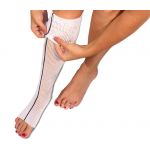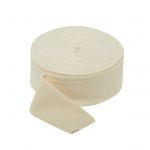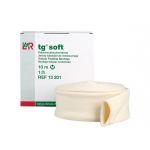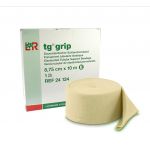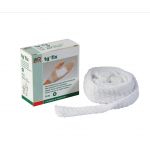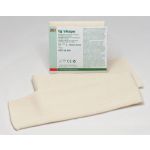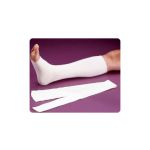Tubular Elastic Bandages
Tubular Bandages For Lymphedema
Tubular elastic bandages are used to provide 360 degree uniform compression and support, and are commonly used in treating lymphedema, prevention of edema, and to reduce post-burn scarring.
Shop our tubular elastic bandages with pre-tax savings using your FSA or HSA account!
Tubular Bandages For Lymphedema
Designed with a specific weave that self-adjusts to provide continuous and even support and pressure, tubular elastic bandages provide flexibility of movement, with minimal constriction. Tubular elastic bandages secure without the use of clips or tape, and are available in a variety of widths, lengths and styles. The bandages can also be easily cut into the desired length.
When used under short stretch compression bandages (as part of a multi-layer compression bandage application), tubular elastic bandages apply gentle, uniform pressure, as well as provide a layer of support and skin protection. The elasticated bandages are also often used in conjunction with medical foam padding and pads.
Tubular elastic bandages are ideal not only for lymphedema and edema treatments, but also for post-cast support, wound dressing retention, and the treatment of sprains, strains and other soft tissue injuries.
Our selection of tubular bandages includes:
- Comperm LF tubular bandages
- TG Grip tubular bandages
- TG Fix tubular bandages
- TG Soft tubular bandages
- TG Shape tubular bandages
- X-Span tubular bandages
- Tensoshape tubular bandages
- Juzo Cotton compression stockinettes
- EdemaWear compression stockinette
FAQs About Tubular Bandages
Tubular bandages provide compression and support for the management of lymphedema. Below are some of the most frequently asked questions about tubular bandages.
- What Are Tubular Bandages
- How Do Tubular Bandages Help With Lymphedema
- What Are The Most Common Uses For Tubular Bandages
- Are There Different Levels Of Compression In Tubular Bandages
- light compression tubular bandages (used for mild lymphedema, chronic venous insufficiency, minor sprains and strains, and as support for weakened joints)
- medium compression tubular bandages (used for moderate lymphedema and edema, moderate sprains and injuries, and post-surgery recovery)
- heavy compression tubular bandages (used for severe lymphedema and edema, varicose vein treatments, and severe sprains and injuries)
- How Do I Choose The Right Size Of Tubular Bandages
- How Tight Should My Tubular Bandage Be
- How Long Should I Wear My Tubular Bandage Each Day
- When Should I Replace My Tubular Bandage
- Can Tubular Bandages Be Washed And Reused
- What Is The Difference Between A Tubular Bandage And A Tubular Stockinette
- Do I Need A Prescription To Get Tubular Bandages
- Do Insurance Companies Cover Tubular Bandages
- Does Medicare Cover Tubular Bandages
Tubular bandages are stretchable bandages that are used to apply consistent pressure and support to limbs affected by lymphedema. Their tube shape makes them easy to slip over arms and legs, and they evenly distribute compression.
Tubular bandages help reduce swelling, by pushing lymph fluid out of the affected limb. The compression that the elastic bandage provides helps maintain limb shape, prevent fluid accumulation, and enhance circulation.
In addition to treating and managing lymphedema, tubular bandages are also often used to treat soft tissue injuries, sprains, and strains, as well as to prevent edema and reduce post-burn scarring.
Tubular elastic bandages are available in different levels of compression:
For all of our tubular bandages, we have sizing charts from the manufacturer. For most bandages, to ensure the correct fit, you will take multiple circumference measurements at different parts of your limb.
Your tubular bandage should provide comfortable compression, without causing pain or throbbing. After you have applied the elastic bandage, you should check for signs of poor circulation (such as numbness, tingling, increased pain, coolness, or a blue or pale color in your fingers or toes. These signs indicate that the tubular bandage is too tight.
When checking for proper fit, you can also use the “two-finger” rule: When the tubular bandage is on, you should be able to comfortably slide two fingers under the bandage. If you cannot do this, it is too tight. If the bandage is loose and slips, it needs to be adjusted.
Another way to check for proper fit is to observe the swelling in your limb. If swelling increases below the tubular bandage, it might be applied too tightly. If swelling increases above the bandage, it might be too loose or applied incorrectly.
Your healthcare provider should make specific recommendations. In general, however, tubular elastic bandages are worn during the day and removed at night.
Because tubular bandages are primarily used to provide compression, you should replace your bandage when it begins to lose elasticity. Also, you will want to swap out bandages (potentially daily) if you sweat a lot, if the bandage is in direct contact with an open wound, or if the bandage gets wet or dirty.
Most tubular bandages can be washed and reused. If you wash them, use a mild detergent and lukewarm water, then air dry them. Avoid fabric softeners and bleach, as they can degrade the material. If you wash your tubular bandage in a washer, use a gentle cycle and place the bandage in a mesh laundry bag to prevent it from snagging or tangling with other items in your laundry load.
Tubular bandages are used to apply compression, while tubular stockinettes serve as a protective underlayer beneath compression bandages and garments.
No. You can order all of our tubular bandages without a prescription.
Some insurance plans cover tubular bandages, with a prescription for compression bandaging. Check with your insurance provider for specifics about your coverage.
Starting in January 2024, thanks to the Lymphedema Treatment Act, Medicare began covering compression products, including compression bandaging systems and supplies that are used during the initial decongestion phases and maintenance phases of lymphedema treatment. Click here to read more about the Lymphedema Treatment Act and how to order tubular bandages.
Please note that all of the information above is for general informational purposes. Please consult your healthcare provider for specific information and personalized recommendations for your situation.
For more information about our tubular bandages for lymphedema, please call (800) 700-1032, or e-mail info@bandagesplus.com
••••••••••••••••••••••••••••••••••••Medicare Pays For Lymphedema Products
Please note: Thanks to the Lymphedema Treatment Act, which took effect on January 1, 2024, Medicare began to pay for lymphedema products for those who have Medicare B coverage and meet certain other coverage criteria. Please visit our website page covering the details of the Lymphedema Treatment Act to obtain more information about how Medicare pays for lymphedema garments, wraps, and bandages.


